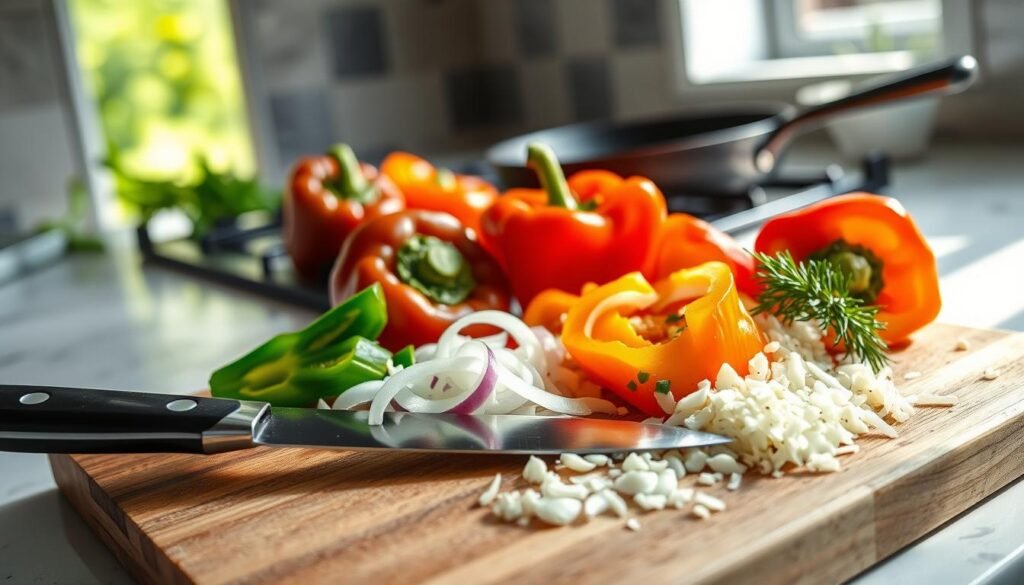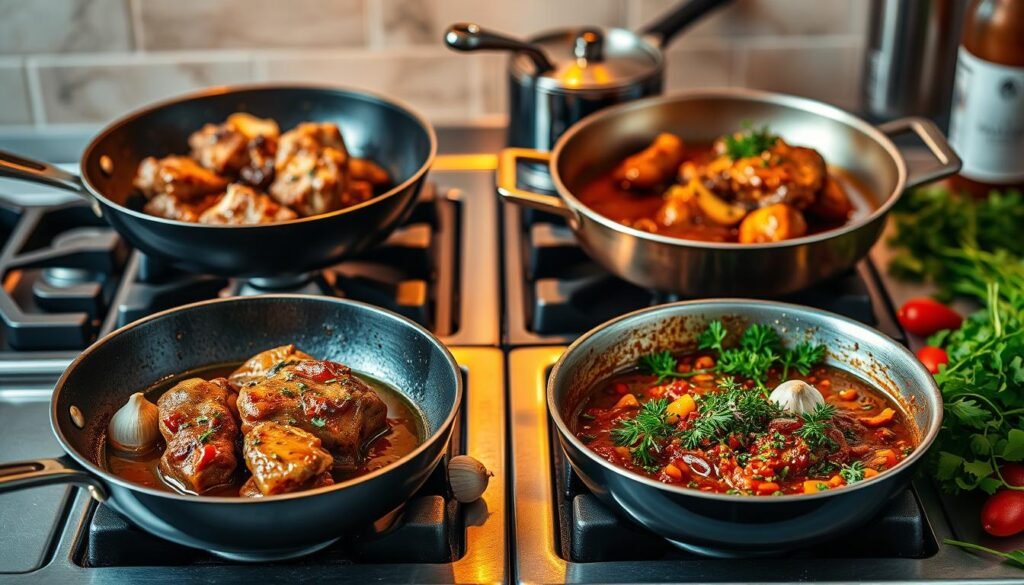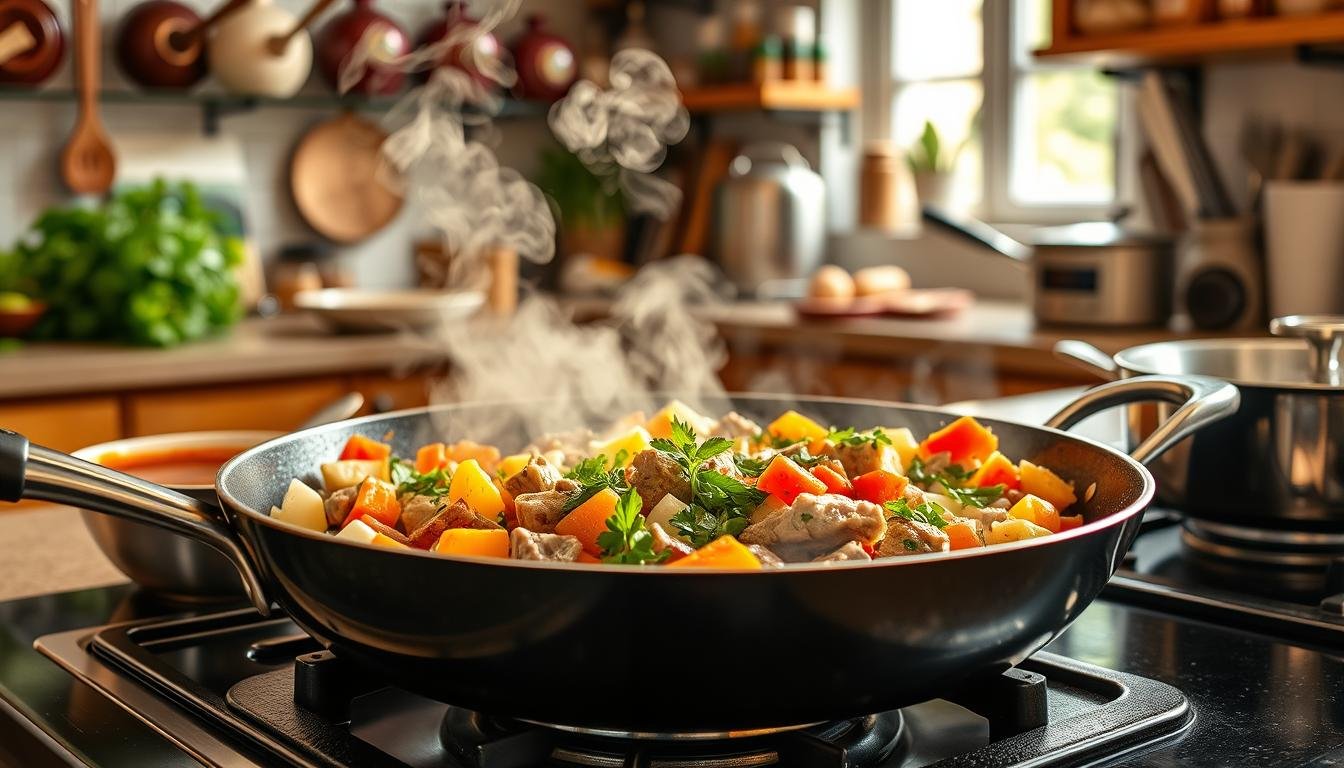Pan-Frying 101: Unlock the Secrets to Flawless Stovetop Cooking
Every kitchen has a story, and mine started with a sizzling pan. It changed my cooking journey. That first perfectly crisp piece of chicken showed me stovetop cooking is an art.
Pan-frying is simple yet sophisticated. It can make your meals special. On your stovetop, heat, oil, and ingredients come together for golden-brown perfection.
This guide will make pan-frying easy. You’ll learn to make dishes like restaurants in your kitchen. We’ll show you how to turn simple ingredients into crispy, tasty meals that wow everyone.
Table of Contents
Understanding Pan-Frying: The Basics
Pan-frying turns simple ingredients into tasty meals with a crispy outside. It cooks food in a skillet with a bit of oil. This makes the outside golden while keeping the inside juicy.
Let’s explore the basics of oil frying. It’s loved by both home cooks and chefs.
What is Pan-Frying?
Pan-frying cooks food in a shallow layer of oil in a skillet. The oil is about 1/4 inch deep. It’s cooked over medium to high heat. This method uses less oil than deep-frying but gives a crispy texture.
Cooking Method Comparisons
| Cooking Method | Oil Amount | Heat Level | Texture Result |
|---|---|---|---|
| Pan-Frying | 1/4 inch | Medium-High | Crispy exterior |
| Deep-Frying | Fully submerged | High | Completely crisp |
| Sautéing | Minimal oil | Medium | Lightly browned |
Knowing these differences helps you pick the best method for your dish. Pan-frying is great for flavor, texture, and efficiency.
Key Pan-Frying Insights
- Ideal oil temperature: 350°F to 375°F
- Cooking time: 3-5 minutes per side for thin cuts
- Use a heavy-bottomed skillet for even heat distribution
“Pan-frying is an art that transforms simple ingredients into restaurant-quality dishes with minimal effort.” – Culinary Expert
Learning pan-frying lets you make amazing meals at home. It’s like having a restaurant in your kitchen.
Essential Tools for Pan-Frying
Starting with the right tools is key to making tasty pan-fried dishes. Professional chefs know that the right skillet and utensils can make a big difference. They can turn your cooking into something truly special.
Choosing the Right Pan
Your skillet is the base of great pan-frying. Each material has its own benefits:
- Stainless steel with aluminum core spreads heat well
- Cast iron keeps heat for a long time
- Non-stick pans are best for soft foods
Recommended Cookware Materials
| Material | Heat Distribution | Durability |
|---|---|---|
| Stainless Steel | Excellent | High |
| Cast Iron | Good | Very High |
| Non-Stick | Moderate | Medium |
Must-Have Utensils for Pan-Frying
Having the right tools is essential for your cooking technique. You’ll need:
- Silicone spatulas for gentle handling
- Wooden spoons for stirring
- Tongs for precise food handling
- Meat thermometer to check food doneness
“The right tools can elevate your cooking from good to exceptional.” – Professional Chef Insight
Investing in quality cookware and utensils will greatly enhance your pan-frying. It will make cooking more fun and professional.
Selecting the Best Ingredients for Pan-Frying
Creating a delicious dish starts with choosing the right ingredients. Pan-frying is a versatile method that can turn simple foods into culinary masterpieces. It’s easy to follow.
The key to successful pan-frying is picking ingredients that can handle high heat. They should also develop incredible flavor and texture.
Types of Proteins Perfect for Pan-Frying
Not all proteins are created equal for pan-frying. Some stand out more than others:
- Chicken breasts
- Thin beef steaks
- Pork chops
- Fish fillets
Seafood is a standout in pan-frying. Its delicate nature works well with quick, high-heat cooking.
Vegetables That Elevate Pan-Fried Dishes
The right vegetables can make your pan-fried meal amazing:
| Vegetable | Cooking Characteristic |
|---|---|
| Bell Peppers | Caramelizes quickly |
| Zucchini | Develops crispy edges |
| Mushrooms | Absorbs flavors wonderfully |
| Onions | Creates sweet, golden brown texture |
“The secret to a perfect pan-fried dish is selecting ingredients that complement each other and can withstand high heat.”
Remember, thinner cuts of protein and smaller vegetable pieces are best for pan-frying. Your goal is to get a crispy exterior and a juicy, tender interior.
Preparing Your Ingredients
Starting a delicious dish begins with careful ingredient prep. Pan-frying turns simple items into culinary wonders. The right prep can make an easy recipe stand out.

- Pat ingredients dry for a crispy outside
- Let proteins warm up to room temperature
- Cut ingredients the same size for even cooking
Mastering Seasoning Techniques
Seasoning is an art that can change your dish. It’s about adding flavor without overpowering the taste of your ingredients. Start with kosher salt and freshly ground black pepper for a great base.
“Seasoning is the secret weapon of every great cook” – Professional Chef
Precision Cutting for Perfect Results
Cutting right is key for even cooking. Here are tips for meats like chicken or fish:
- Butterfly thick chicken breasts for even cooking
- Cut veggies into similar sizes
- Use a sharp knife for clean cuts
| Ingredient Type | Recommended Cutting Technique | Cooking Time Impact |
|---|---|---|
| Chicken Breast | Butterfly or pound to even thickness | Reduces cooking time by 30% |
| Vegetables | Uniform 1/2 inch pieces | Ensures consistent cooking |
| Fish Fillets | Even thickness, remove skin if desired | Prevents uneven cooking |
Pro tip: Cold ingredients can make oil temperature drop, leading to soggy food. Always warm ingredients to room temperature before pan-frying.
The Importance of Temperature Control
Mastering stovetop cooking is all about precision, and temperature control is key. Knowing how heat affects your cooking can turn simple meals into amazing dishes.
Preheating Your Pan: The Foundation of Great Cooking
Getting your pan ready is essential for great results. Here’s how to make sure your pan is perfect:
- Start with a clean, dry pan
- Set burner to medium-high heat
- Allow 2-3 minutes for even heat distribution
- Test pan readiness using the water droplet method
Detecting Oil Temperature Readiness
Knowing when your oil is ready is critical. Chefs use several methods to check oil temperature:
| Oil Temperature Range | Cooking Purpose | Visual Cues |
|---|---|---|
| 320-350°F | Gentle frying | Slight shimmer, no smoking |
| 350-375°F | Standard pan-frying | Moderate rippling effect |
| 375-400°F | High-heat searing | Visible heat waves |
“Temperature is the secret weapon in every chef’s arsenal.” – Professional Culinary Institute
The water droplet test is a great way to check if your pan is ready. Sprinkle a few water drops onto the surface. If they dance and evaporate right away, your pan is ready for cooking.
Perfecting the Pan-Frying Technique
Mastering pan-frying takes precision and practice. It turns simple ingredients into golden brown dishes that excite your taste buds and wow your guests.
Pan-frying is more than just cooking in a skillet. It’s a skill that needs focus and heat control knowledge.
Step-by-Step Pan-Frying Guide
- Choose a heavy-bottomed pan for even heat
- Use high-quality oil with a high smoke point
- Preheat the pan to 300°F to 350°F
- Pat ingredients dry for better browning
- Add ingredients without crowding the pan
Critical Techniques for Success
Getting that golden brown color takes patience. Don’t flip your food too often. Let each side get crispy before flipping.
| Cooking Technique | Oil Volume | Temperature Range |
|---|---|---|
| Pan Frying | 1/3 ingredient thickness | 300°F – 350°F |
| Shallow Frying | 1/2 ingredient thickness | 350°F – 375°F |
Common Mistakes to Dodge
- Using oil that’s not hot enough
- Moving food too frequently
- Overcrowding the pan
- Skipping the preheating step
“The secret to perfect pan-frying is understanding your pan’s heat and respecting each ingredient’s unique cooking needs.”
Pro tip: Use a digital thermometer to check oil temperature. This helps your ingredients cook evenly without too much grease.
Timing: How Long to Pan-Fry
Mastering pan-frying needs precision and knowing cooking times. Your technique can make a meal delicious or not. So, it’s key to know how long to cook each ingredient for a tasty dish every time.
Cooking times change a lot based on the food. Each ingredient needs a special way to cook for the best results.
Cook Times for Various Foods
Here’s a guide to help you with pan-frying times:
- Thin pork chops: 5 minutes total
- First side: 2-3 minutes
- Second side: 1-2 minutes
- Vegetables: 2-3 minutes
- Thin fish fillets: 3-4 minutes
- Chicken breasts: 6-8 minutes
Precision Timing Strategies
Using a kitchen timer makes cooking precise. Visual cues are also key – look for golden edges and listen for sizzle to check heat.
“Timing is everything in pan-frying. A minute too long can turn a perfect dish into a culinary disaster.” – Professional Chef
| Ingredient | Thickness | Cooking Time | Heat Level |
|---|---|---|---|
| Pork Chops | Thin | 5 minutes total | Medium |
| Chicken Breast | Medium | 6-8 minutes | Medium-High |
| Fish Fillets | Thin | 3-4 minutes | Medium |
Remember, food keeps cooking a bit after you take it off the heat. Let it rest for a few minutes. This ensures even cooking and the best flavor.
Sauces and Seasonings to Elevate Flavor
Creating a delicious dish is more than just cooking. The right sauces and seasonings can turn a simple meal into a masterpiece. Pan-frying allows you to create rich, complex flavors that make your dish stand out.

Home cooks can unlock amazing flavors by making sauces strategically. 70% of home cooks say pan sauces make their meals better. Let’s look at some ways to season and sauce like a pro.
Mastering Pan Sauces
When you pan-fry proteins like chicken, duck, or steak, deglazing is key.
“The fond – those delicious browned bits – holds concentrated flavor waiting to be transformed”
. Here are some tips for making amazing pan sauces:
- Use wine, stock, or broth to deglaze the pan
- Sweat aromatics like garlic and shallots for 2 minutes
- Reduce cooking liquid by ½ to concentrate flavors
- Add a touch of butter or cream for silky texture
Creative Seasoning Techniques
Seasoning is just as important as sauce-making. Try these creative seasoning ideas:
- Develop custom spice blends
- Experiment with herb-based marinades
- Layer flavors throughout the cooking process
- Balance seasonings carefully
With these techniques, you’ll turn simple pan-frying into a flavorful journey. Your meals will be unforgettable!
Cleaning and Maintenance of Your Pan
Proper care of your skillet is key to keeping it in top shape. Your kitchen technique is just as important when cleaning as it is when cooking. Learning how to clean and maintain your cookware can save you money and help you cook better.
Professional chefs say cleaning your pan right after cooking stops tough residue from forming. 80% of cooking professionals recommend avoiding dishwashers to preserve pan quality.
Essential Cleaning Steps
- Let the pan cool down naturally
- Rinse with warm water
- Use soft sponges or cloths
- Dry thoroughly after washing
Material-Specific Maintenance
Different pan materials need special care:
- Stainless steel: Avoid harsh abrasives
- Cast iron: Season regularly with oil
- Non-stick: Use gentle cleaning methods
“A well-maintained pan is the secret to consistent cooking performance.”
30% of home cooks report improved pan performance through proper maintenance. Your kitchen technique can make a big difference in your cookware’s life.
Quick Maintenance Tips
- Never use steel wool
- Store in dry environments
- Apply light oil after cleaning for protection
- Check for any signs of wear
By spending just a few minutes on proper cleaning, your skillet will stay a trusted cooking partner for years.
Troubleshooting Common Pan-Frying Issues
Mastering any cooking method means knowing the common problems. Pan-frying can face issues even for skilled cooks. Learning how to fix these problems will help you cook better every time.
Solutions for Sticking or Burning Food
Food sticking to the pan often happens when there’s not enough oil or the wrong heat. Use oils like avocado or grapeseed that can handle high heat. Make sure your skillet is hot for at least five minutes before adding food.
Also, dry your ingredients before cooking. This helps prevent sticking when you’re pan-frying.
Adjusting for Too Much Grease or Oil
Too much oil can make your food greasy. Use a paper towel to soak up excess oil after cooking. Choose lean cuts of meat and don’t overcrowd the pan.
Medium to medium-high heat is usually best. It helps your food get a nice golden-brown color without soaking up too much oil.
FAQ
What exactly is pan-frying?
What types of foods work best for pan-frying?
What pan material is recommended for pan-frying?
How do I prevent food from sticking to the pan?
What oil is best for pan-frying?
How do I know when my pan is at the right temperature?
Can I pan-fry without using a lot of oil?
How do I clean my pan after pan-frying?
What’s the difference between pan-frying and deep-frying?
How can I prevent oil splatter while pan-frying?
Source Links
- The Secret to Tossing Food in a Skillet Like a Pro, According to a Chef – https://www.seriouseats.com/how-to-toss-food-in-a-skillet-8768788
- Pot Lid as Splatter Guard: A Simple Solution for Stovetop Messes | Cosmo Appliances – https://cosmoappliances.com/pot-lid-as-splatter-guard-a-simple-solution-for-stovetop-messes/
- Pan Frying 101: Essential Techniques for Crispy and Flavorful Dishes – https://www.mykitchenhacks.com/frytopia/the-basics-of-pan-frying/
- Frying Pan Types Explained: Choosing the Best Option – https://debuyer-usa.com/blogs/guides/frying-pan-types-explained-choosing-the-best-option?srsltid=AfmBOooJ7CBtQ-PaC23Qjzq1dd1KHcVVOIPAe8PM3_53glUCSjqYo6ER
- The Ultimate Frying Pan Guide – https://www.tasteofhome.com/article/frying-pan-guide/?srsltid=AfmBOooANjJWkonPBaG_nmRtDOJ_H0bkXAhXiV5qXuLKbAUAkGwaFbGp
- Must Have Kitchen Tools That Will Up Your Kitchen Game! – https://chefjeanpierre.com/kitchen-tips-tricks-and-techniques/must-have-kitchen-tools/
- The Kitchen Starter Kit: Essential Tools for Every Cook – https://www.seriouseats.com/basic-starter-kitchen-equipment
- What’s The Real Difference Between Deep-Frying And Pan-Frying? – https://www.yahoo.com/lifestyle/whats-real-difference-between-deep-194045092.html
- Pan Frying Vs. Deep Frying – What’s The Difference? Which Method Makes Your Food Extra Crispy? – https://food.ndtv.com/food-drinks/pan-frying-vs-deep-frying-whats-the-difference-which-method-makes-your-food-extra-crispy-6498798
- How to Pan-Fry Everything From Dumplings to Schnitzel Like a Chef – https://www.foodandwine.com/how-to-pan-fry-8642149
- How to Shallow Fry: 13 Steps (with Pictures) – wikiHow – https://www.wikihow.com/Shallow-Fry
- Perfect Pan-fried Steaks – Ztove – https://ztove.com/recipes/perfect-pan-fried-steaks/
- What’s The Real Difference Between Deep-Frying And Pan-Frying? – Chowhound – https://www.chowhound.com/1756364/difference-deep-and-pan-frying/
- Deep Frying vs Pan Frying: Texas Culinary Techniques Compared – https://www.simplytexan.com/texas-home-cooking/frying-up-a-storm-deep-frying-vs-pan-frying/
- Shallow Frying Tips And Tricks: Mastering the Art in 5 Easy Steps! | SMCo – https://smcoaz.com/learn-to-cook/shallow-frying-tips-and-tricks-mastering-the-art-in-5-easy-steps/
- Ree’s Pan-Fried Pork Chops Are Ready in 10 Minutes – https://www.thepioneerwoman.com/food-cooking/recipes/a9893/simple-pan-fried-pork-chops/
- Crispy Pan-Fried Potatoes Are Even Better Than French Fries – https://www.delish.com/cooking/a23463225/pan-fried-potatoes/
- How to Make an Easy Pan Sauce – https://madeincookware.com/blogs/pan-sauce
- Easy Stir Fry Sauce – https://www.simplywhisked.com/orange-pork-stir-fry/
- Hoisin Sauce (Better than Store-Bought) – https://www.inspiredtaste.net/57919/hoisin-sauce/
- How to Properly Clean a Frying Pan – https://madeincookware.com/blogs/how-to-clean-a-skillet
- Guide: Take good care of your frying pans – https://www.evasolo.com/en/blog/guide-take-good-care-of-your-frying-pans?srsltid=AfmBOoqNOLLmhrFsF9SOTjU58Ono388HbM5KscwmYw5N6h4c4X1cGB7I
- Common Mistakes You’re Making With Your Cast Iron Skillet — And How To Fix Them – Tasting Table – https://www.tastingtable.com/1716078/cast-iron-skillet-mistakes-problem-how-to-fix/
- Induction Cookers: How to Troubleshoot Hob and Pan Problems – https://castey.com/en/my-frying-pan-doesnt-work-the-hob-doesnt-detect-it-how-to-solve-problems-with-induction-cookers/
- Say Goodbye to Sticking: How to Use Your Titanium Frying Pan Like a Pro – https://silverantoutdoors.com/blogs/the-silverant-blog/say-goodbye-to-sticking-how-to-use-your-titanium-frying-pan-like-a-pro

